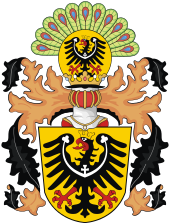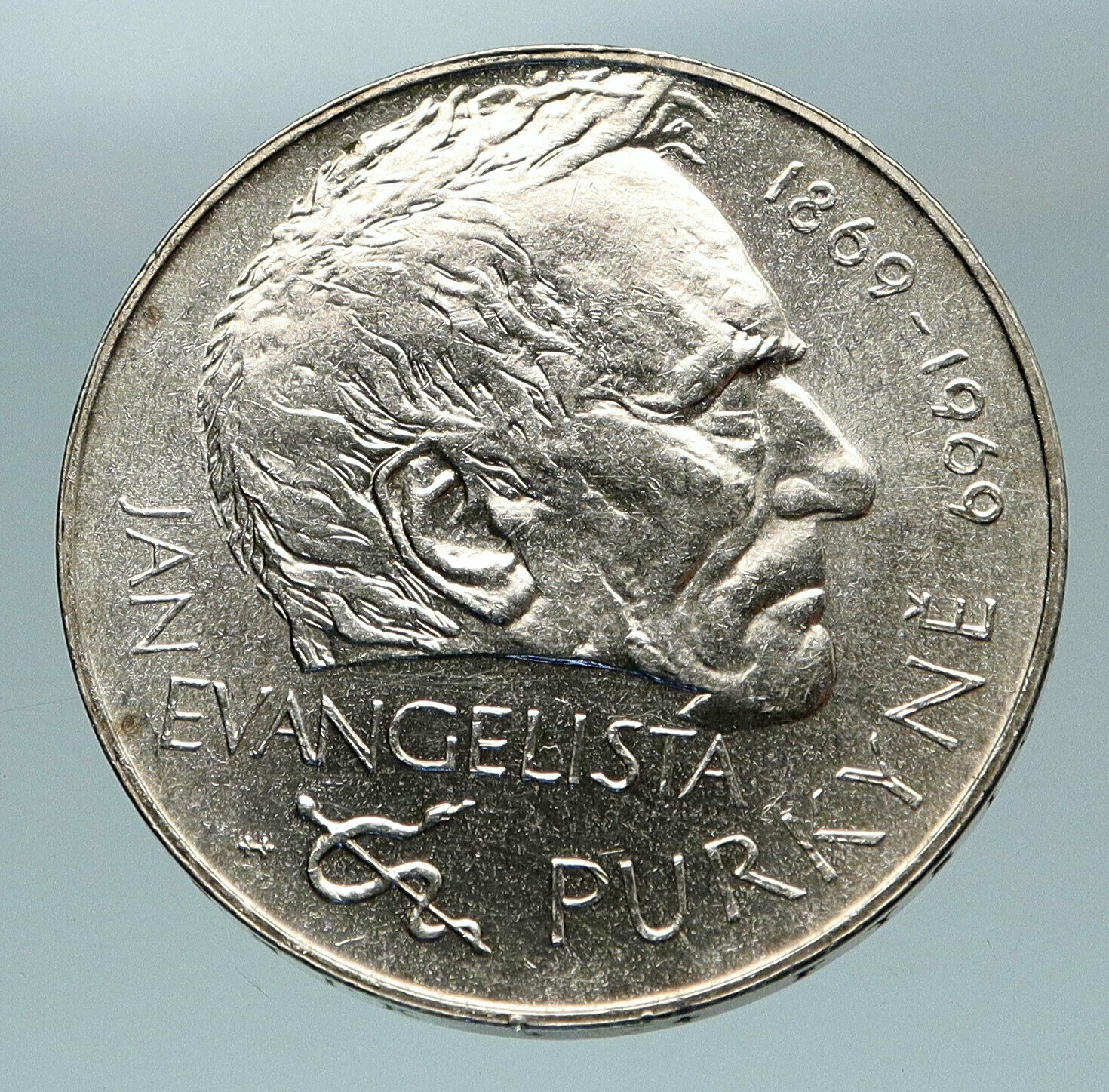|
Kingdom of Bohemia – Silesia – Leopold I, “The Hogmouth,” as King of Bohemia – Holy Roman Emperor (18 July 1658 – 5 May 1705)
1701 Silver 3 Kreuzer 20mm (1.62 grams)
Reference: KM# 504, Her# 1550-1561
LEOPOLDVS D G R I S (3) A G H B REX, Leopold facing right.
ARCHID AVS (FN) DVX BVR SIL, Crowned double headed imperial eagle in an inner circle.
You are bidding on the exact item pictured, provided with a Certificate of Authenticity and Lifetime Guarantee of Authenticity.
 Leopold I (name in full: Leopold Ignaz Joseph Balthasar Felician; Hungarian: I. Lipót; 9 June 1640 – 5 May 1705) was Holy Roman Emperor, King of Hungary, Croatia, and Bohemia. The second son of Ferdinand III, Holy Roman Emperor, by his first wife, Maria Anna of Spain, Leopold became heir apparent in 1654 by the death of his elder brother Ferdinand IV. Elected in 1658, Leopold ruled the Holy Roman Empire until his death in 1705. Leopold I (name in full: Leopold Ignaz Joseph Balthasar Felician; Hungarian: I. Lipót; 9 June 1640 – 5 May 1705) was Holy Roman Emperor, King of Hungary, Croatia, and Bohemia. The second son of Ferdinand III, Holy Roman Emperor, by his first wife, Maria Anna of Spain, Leopold became heir apparent in 1654 by the death of his elder brother Ferdinand IV. Elected in 1658, Leopold ruled the Holy Roman Empire until his death in 1705.
Leopold’s reign is known for conflicts with the Ottoman Empire in the east and rivalry with Louis XIV, a contemporary and first cousin, in the west. After more than a decade of warfare, Leopold emerged victorious from the Great Turkish War thanks to the military talents of Prince Eugene of Savoy. By the Treaty of Karlowitz, Leopold recovered almost all of the Kingdom of Hungary, which had fallen under Turkish power in the years after the 1526 Battle of Mohács.
Leopold fought three wars against France: the Franco-Dutch War, the Nine Years’ War, and the War of the Spanish Succession. In this last, Leopold sought to give his younger son the entire Spanish inheritance, disregarding the will of the late Charles II. Leopold started a war that soon engulfed much of Europe. The early years of the war went fairly well for Austria, with victories at Schellenberg and Blenheim, but the war would drag on till 1714, nine years after Leopold’s death, which barely had an effect on the warring nations. When peace returned, Austria could not be said to have emerged as triumphant as it had from the war against the Turks.
 Silesia is a historical region of Central Europe located mostly in Poland, with small parts in the Czech Republic and Germany. Its area is approximately 40,000 km2 (15,400 sq mi) and the population is estimated at around 8,000,000 inhabitants. Silesia is split into two main sub-regions of Lower Silesia in the west and Upper Silesia in the east. Silesia has a diverse culture, including architecture, costumes, cuisine, traditions and the Silesian language. Silesia is a historical region of Central Europe located mostly in Poland, with small parts in the Czech Republic and Germany. Its area is approximately 40,000 km2 (15,400 sq mi) and the population is estimated at around 8,000,000 inhabitants. Silesia is split into two main sub-regions of Lower Silesia in the west and Upper Silesia in the east. Silesia has a diverse culture, including architecture, costumes, cuisine, traditions and the Silesian language.
In the second half of the 2nd millennium B.C. (late Bronze Age), Silesia belonged to the Lusatian culture. About 500 BC Scyths arrived, and later Celts in the South and Southwest. During the 1st century BC Silingi and other Germanic people settled in Silesia. For this period we have written reports of antique authors who included the area. Slavs arrived in this territory around the 6th century. The first known states in Silesia were those of Greater Moravia and Bohemia. In the 10th century, Mieszko I incorporated Silesia into Civitas Schinesghe, a Polish state. It remained part of Poland until the Fragmentation of Poland. Afterwards it was divided between Piast dukes, descendants of Władysław II the Exile, High Duke of Poland.
 In the Middle Ages, Silesia was divided among many duchies ruled by various dukes of the Piast dynasty. During this time, cultural and ethnic German influence increased due to immigrants from the German-speaking components of the Holy Roman Empire, as the region’s economy developed, and towns were founded under German town law. In the Middle Ages, Silesia was divided among many duchies ruled by various dukes of the Piast dynasty. During this time, cultural and ethnic German influence increased due to immigrants from the German-speaking components of the Holy Roman Empire, as the region’s economy developed, and towns were founded under German town law.
Between the years 1289-1292 Bohemian king Wenceslaus II became suzerain of some Upper Silesian duchies. Silesia subsequently became a possession of the Crown of Bohemia under the Holy Roman Empire in the 14th century, and passed with that Crown to the Habsburg Monarchy in 1526. The Duchy of Crossen was inherited by Margraviate of Brandenburg in 1476 and, with the renunciation by King Ferdinand I and estates of Bohemia in 1538, it became an integral part of Brandenburg.
In 1742, most of Silesia was seized by King Frederick the Great of Prussia in the War of the Austrian Succession and subsequently made the Prussian Province of Silesia.
After World War I, Lower Silesia, having by far a German majority, remained with Germany while Upper Silesia, after a series of insurrections by the Polish inhabitants, was split. Part joined the Second Polish Republic and was administered as the Silesian Voivodeship. The Prussian Province of Silesia within Germany was divided into the Provinces of Lower Silesia and Upper Silesia. Austrian Silesia (officially: Duchy of Upper and Lower Silesia; almost identical with modern-day Czech Silesia), the small portion of Silesia retained by Austria after the Silesian Wars, became part of the new Czechoslovakia. During the Second World War, Nazi Germany invaded Polish parts of Upper Silesia. Jews were subject to genocide in the Holocaust, while German plans towards Poles involved ethnic cleansing and biological extermination.
In 1945 both provinces were occupied by the Soviet Union. Under the demands in the Potsdam Agreement, most of this territory was afterwards transferred to the Polish People’s Republic. Most of the German population, who had not been evacuated or had fled, were expelled by the newly arrived Polish administration, while Poles expelled from the eastern Polish Borderlands then settled in the region.
The Kingdom of Bohemia, sometimes later in English literature referred to as the Czech Kingdom (Czech: České království; German: Königreich Böhmen; Latin: Regnum Bohemiae, sometimes Regnum Czechorum), was a medieval and early modern monarchy in Central Europe, the predecessor of the modern Czech Republic. It was an Imperial State in the Holy Roman Empire, and the Bohemian king was a prince-elector of the empire. The kings of Bohemia, besides Bohemia, also ruled the Lands of the Bohemian Crown, which at various times included Moravia, Silesia, Lusatia, and parts of Saxony, Brandenburg, and Bavaria.
The kingdom was established by the Přemyslid dynasty in the 12th century from Duchy of Bohemia, later ruled by the House of Luxembourg, the Jagiellonian dynasty, and since 1526 by the House of Habsburg and its successor house Habsburg-Lorraine. Numerous kings of Bohemia were also elected Holy Roman Emperors and the capital Prague was the imperial seat in the late 14th century, and at the end of the 16th and beginning of the 17th centuries.
After the dissolution of the Holy Roman Empire in 1806, the territory became part of the Habsburg Austrian Empire, and subsequently the Austro-Hungarian Empire from 1867. Bohemia retained its name and formal status as a separate Kingdom of Bohemia until 1918, known as a crown land within the Austro-Hungarian Empire, and its capital Prague was one of the empire’s leading cities. The Czech language (called the Bohemian language in English usage until the 19th century) was the main language of the Diet and the nobility until 1627 (after the Bohemian Revolt was suppressed). German was then formally made equal with Czech and eventually prevailed as the language of the Diet until the Czech National Revival in the 19th century. German was also widely used as the language of administration in many towns after the return of Germans immigrated and populated some areas of the country in the 13th century after the Migration Period. The royal court used the Czech, Latin, and German languages, depending on the ruler and period.
Following the defeat of the Central Powers in World War I, both the Kingdom and Empire were dissolved. Bohemia became the core part of the newly formed Czechoslovak Republic.
|





 Leopold I (name in full: Leopold Ignaz Joseph Balthasar Felician; Hungarian: I. Lipót; 9 June 1640 – 5 May 1705) was Holy Roman Emperor, King of Hungary, Croatia, and Bohemia. The second son of Ferdinand III, Holy Roman Emperor, by his first wife, Maria Anna of Spain, Leopold became heir apparent in 1654 by the death of his elder brother Ferdinand IV. Elected in 1658, Leopold ruled the Holy Roman Empire until his death in 1705.
Leopold I (name in full: Leopold Ignaz Joseph Balthasar Felician; Hungarian: I. Lipót; 9 June 1640 – 5 May 1705) was Holy Roman Emperor, King of Hungary, Croatia, and Bohemia. The second son of Ferdinand III, Holy Roman Emperor, by his first wife, Maria Anna of Spain, Leopold became heir apparent in 1654 by the death of his elder brother Ferdinand IV. Elected in 1658, Leopold ruled the Holy Roman Empire until his death in 1705. Silesia is a historical region of Central Europe located mostly in Poland, with small parts in the Czech Republic and Germany. Its area is approximately 40,000 km2 (15,400 sq mi) and the population is estimated at around 8,000,000 inhabitants. Silesia is split into two main sub-regions of Lower Silesia in the west and Upper Silesia in the east. Silesia has a diverse culture, including architecture, costumes, cuisine, traditions and the Silesian language.
Silesia is a historical region of Central Europe located mostly in Poland, with small parts in the Czech Republic and Germany. Its area is approximately 40,000 km2 (15,400 sq mi) and the population is estimated at around 8,000,000 inhabitants. Silesia is split into two main sub-regions of Lower Silesia in the west and Upper Silesia in the east. Silesia has a diverse culture, including architecture, costumes, cuisine, traditions and the Silesian language.  In the Middle Ages, Silesia was divided among many duchies ruled by various dukes of the Piast dynasty. During this time, cultural and ethnic German influence increased due to immigrants from the German-speaking components of the Holy Roman Empire, as the region’s economy developed, and towns were founded under German town law.
In the Middle Ages, Silesia was divided among many duchies ruled by various dukes of the Piast dynasty. During this time, cultural and ethnic German influence increased due to immigrants from the German-speaking components of the Holy Roman Empire, as the region’s economy developed, and towns were founded under German town law. 




